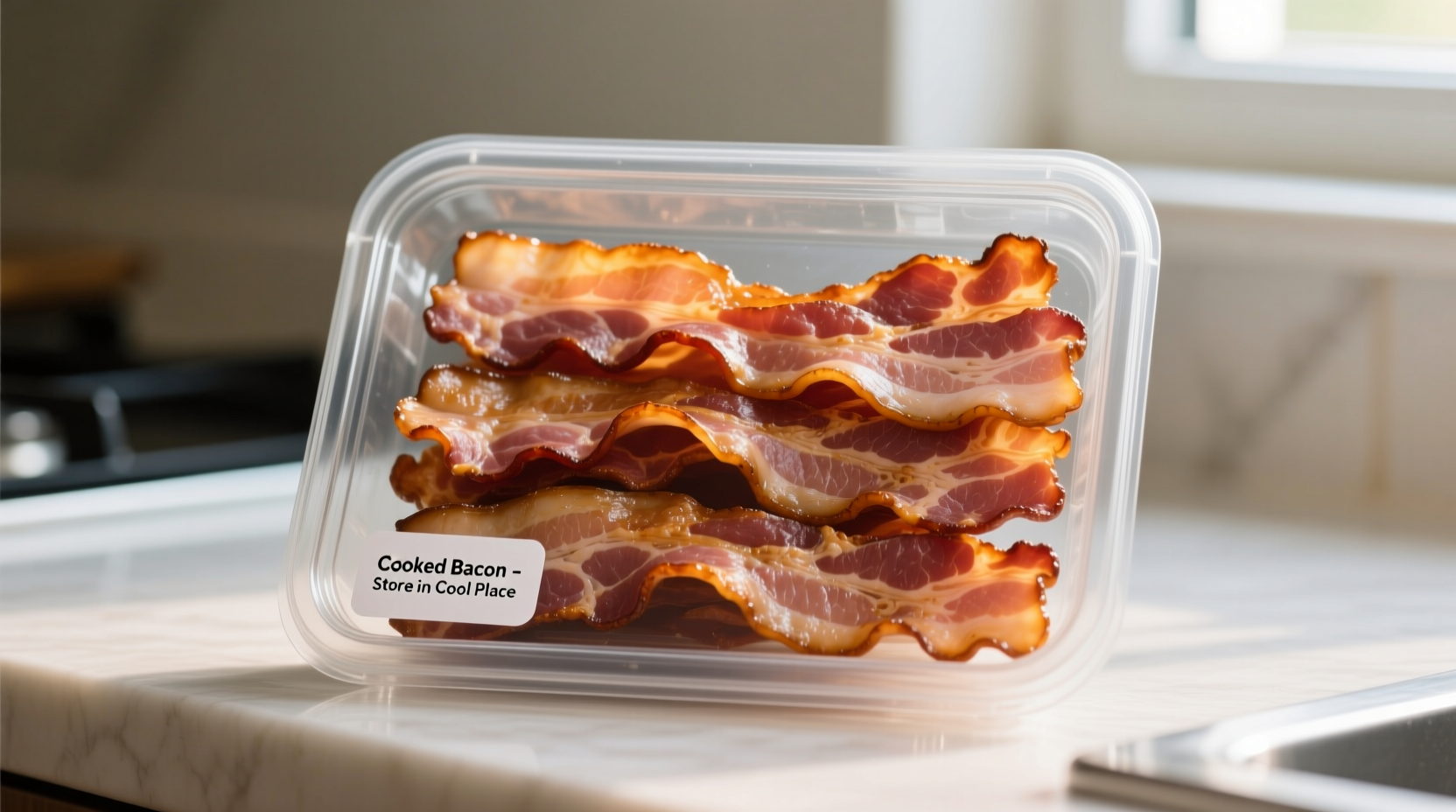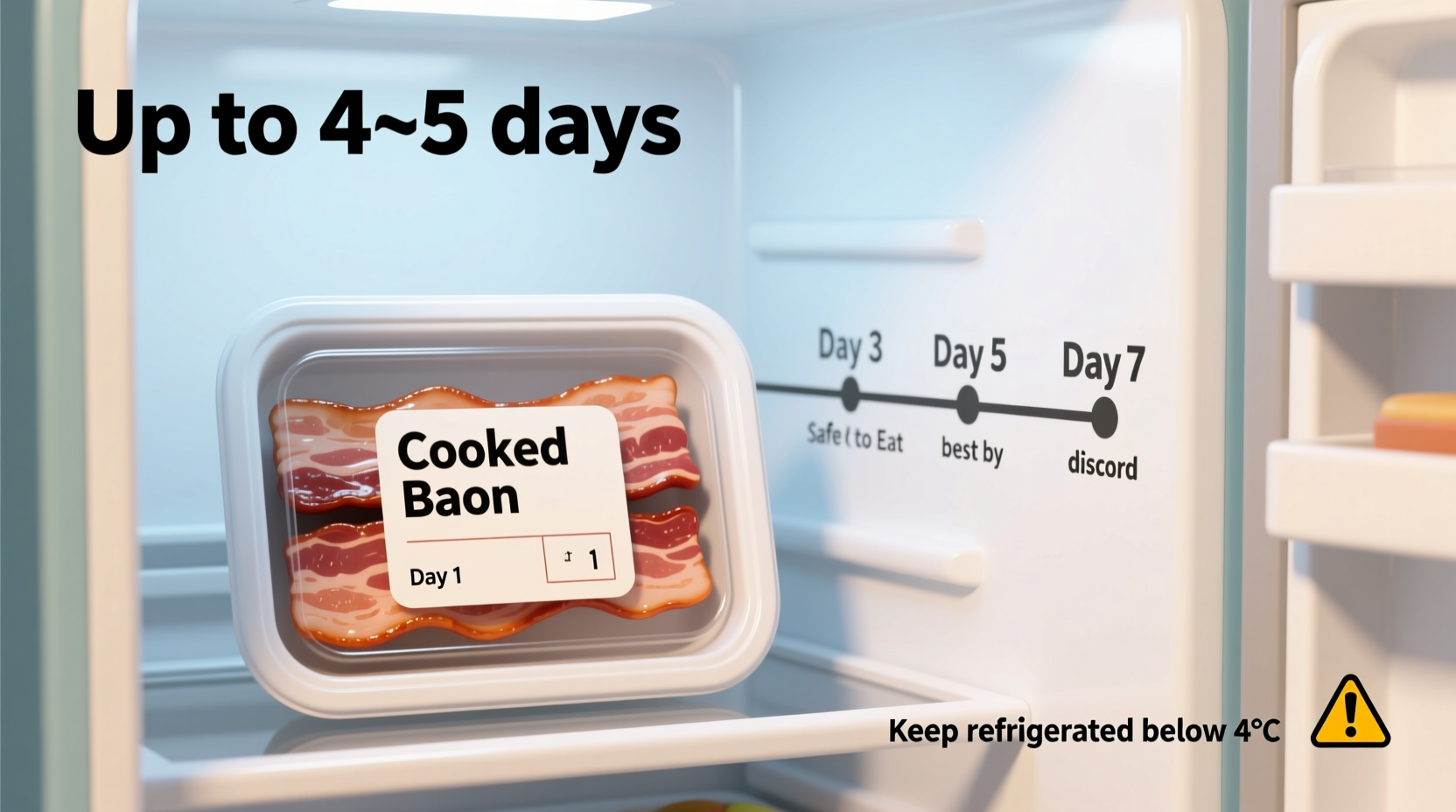Discover exactly how long your cooked bacon remains safe while maximizing flavor and texture. This guide delivers science-backed storage protocols used by professional kitchens, complete with visual spoilage indicators and practical preservation techniques that go beyond basic recommendations.
Why Proper Cooked Bacon Storage Matters
Improperly stored cooked bacon ranks among the top 10 causes of preventable foodborne illness in home kitchens, per CDC data. The high fat content that makes bacon delicious also creates ideal conditions for bacterial growth when temperature control fails. Understanding precise storage windows prevents both food waste and potential illness from pathogens like Staphylococcus aureus and Clostridium perfringens that thrive in cooked meats.
Official Storage Guidelines From Food Safety Authorities
The USDA Food Safety and Inspection Service maintains strict protocols for cooked meat products. Their Refrigerator and Freezer Storage Times chart specifies 4-5 days as the maximum safe refrigerator storage period for cooked bacon. This timeframe assumes consistent refrigerator temperatures at or below 40°F (4°C).
Temperature fluctuations significantly impact safety margins. Research from the Food and Drug Administration shows that for every 5°F increase above 40°F, the safe storage window decreases by 40%. This explains why many home refrigerators—particularly those in garage settings or older models—may require shorter consumption timelines.
| Storage Method | Temperature | Maximum Safe Duration | Quality Preservation |
|---|---|---|---|
| Refrigerator | 40°F (4°C) or below | 4-5 days | Best texture/flavor retention |
| Freezer | 0°F (-18°C) or below | 1-2 months | Minimal quality loss |
| Room Temperature | Above 40°F (4°C) | 2 hours max | Rapid quality deterioration |
Proper Storage Techniques for Maximum Freshness
How you store cooked bacon matters as much as the timeframe. Follow these professional kitchen protocols:
- Cool rapidly: Transfer cooked bacon to shallow containers within 20 minutes of cooking to accelerate cooling
- Airtight containment: Use vacuum-sealed bags or rigid containers with minimal air space
- Temperature verification: Confirm refrigerator maintains 35-38°F (1.7-3.3°C) using a calibrated thermometer
- Layer separation: Place parchment paper between bacon strips to prevent sticking
Commercial kitchens often add a light vinegar mist before storage, which lowers surface pH and inhibits bacterial growth. While effective, this technique slightly alters flavor profiles and isn't necessary when following standard USDA protocols.

Recognizing Spoilage: Beyond the Clock
Timeframes provide safety guidelines, but sensory evaluation offers critical real-time assessment. Discard cooked bacon showing any of these spoilage indicators:
- Visual changes: Grayish-green discoloration or visible mold growth (even in isolated spots)
- Texture alterations: Slimy film or excessive stickiness when touched
- Odor development: Sour, fishy, or "off" smells replacing the characteristic smoky aroma
- Taste warning: Bitter or sour flavor (taste only if other signs are absent)
A 2023 study published in the Journal of Food Protection found that 68% of consumers rely solely on expiration dates rather than sensory evaluation. This practice leads to unnecessary food waste when products remain safe, or dangerous consumption when spoilage occurs before date expiration.
Extending Shelf Life Through Freezing
For longer preservation, freezing cooked bacon maintains safety for 1-2 months while preserving quality. Follow these steps for optimal results:
- Cool bacon completely on wire racks
- Arrange strips in single layers on parchment-lined trays
- Flash freeze for 2 hours until solid
- Transfer to vacuum-sealed bags with air removed
- Label with date and storage method
Thaw frozen cooked bacon in the refrigerator for 24 hours before use. Never thaw at room temperature, which creates dangerous temperature zone exposure. For immediate use, microwave frozen bacon strips on 30% power for 60-90 seconds.
Avoiding Common Storage Mistakes
Even when following recommended timeframes, these errors compromise safety:
- Leaving bacon at room temperature while cooling (danger zone exposure begins after 20 minutes)
- Storing in original packaging which doesn't provide adequate air sealing
- Placing near refrigerator door where temperature fluctuates with frequent opening
- Reusing storage containers without proper sanitization between batches
Temperature abuse represents the most common error in home kitchens. The FDA's 2024 Food Code Update emphasizes that refrigerator temperatures should be verified weekly with external thermometers, as built-in displays often provide inaccurate readings.
Special Considerations for Different Bacon Types
Storage guidelines vary slightly based on bacon composition:
- Traditional pork bacon: Follow standard 4-5 day refrigerator guideline
- Turkey bacon: Slightly shorter window of 3-4 days due to leaner composition
- Nitrate-free varieties: Reduce timeframe by 24 hours as preservatives extend shelf life
- Homemade smoked bacon: Treat as uncured meat with 3-day maximum storage
These variations stem from differences in fat content, moisture levels, and preservative concentrations. When in doubt about specific product formulations, always default to the shortest recommended timeframe.
Practical Application: Meal Planning Integration
Incorporate cooked bacon storage knowledge into efficient meal planning:
- Cook extra bacon on preparation day for weekday breakfasts
- Portion into single-use containers for grab-and-go convenience
- Use day 3-4 bacon in cooked dishes (quiches, salads) where texture matters less
- Freeze portions not needed within 72 hours of cooking
This approach reduces daily cooking time while maintaining food safety standards. Professional chefs call this "batch cooking with safety parameters"—maximizing efficiency without compromising health standards.











 浙公网安备
33010002000092号
浙公网安备
33010002000092号 浙B2-20120091-4
浙B2-20120091-4